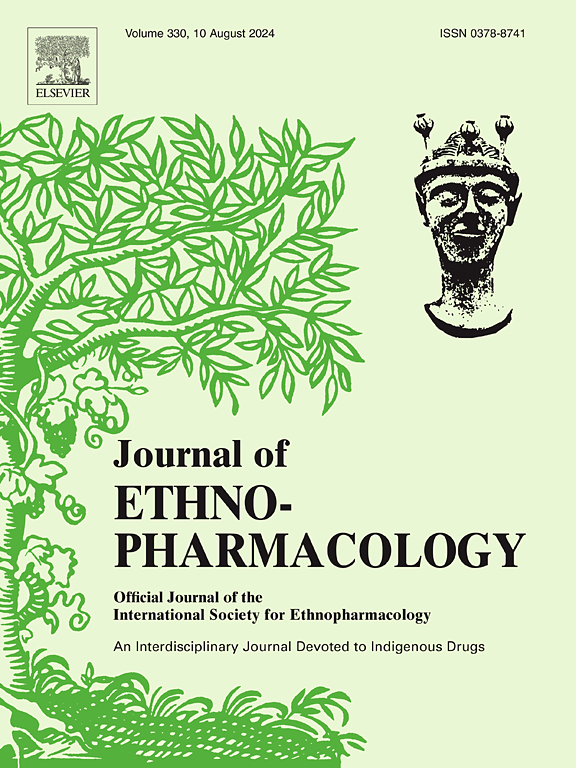Affinity-purified targets screening facilitates active components discovery of Chinese formula —HuGan tablets as a case
IF 4.8
2区 医学
Q1 CHEMISTRY, MEDICINAL
引用次数: 0
Abstract
Ethnopharmacological relevance
Alcoholic Liver Disease (ALD), a chronic condition caused by long-term heavy alcohol consumption, can progress to cirrhosis or liver failure. HuGan Tablets (HGT) is a compound preparation made of six Chinese herbs, which is used in clinic for the treatment of chronic hepatitis, with studies demonstrating its efficacy in alleviating alcohol-induced liver injury in rats. However, the active components and therapeutic targets of HGT remain unclear and require further investigation.
Aim of this study
The aim of this study was to develop a systematic pipeline based on the SPR fishing strategy to identify effective components and therapeutic targets in Chinese formulas, using HGT as a representative case.
Materials and methods
HRMS was employed to analyze HGT ingredients absorbed in rat blood, while network pharmacology, molecular docking and literature mining were utilized to identify potential targets of HGT for ALD alleviation. A systematic SPR-based fishing system was developed by evaluating protein target coupling efficiency, sample recovery rate, specificity of target-small molecule binding, and LOD, and candidate components screened and identified using this system were further screened by SPR affinity tests. Additionally, therapeutic efficacy of the selected compounds was validated in vitro using an ethanol-induced AML12 model and further confirmed in vivo using a mouse model of ALD by assessing markers such as ALT, AST, and oxidative stress indicators.
Results
A total of 128 compounds were identified in HGT, with 29 metabolites detected in rat blood. MFN2, SOD2, mTOR, RXRA, and GSTP1 were identified as anti-ALD targets of HGT through integrated network pharmacology, molecular docking, and literature analysis. An SPR-based active component fishing system was successfully developed, capturing 15 candidate compounds. SPR affinity analysis revealed strong binding (KD: 3.41–221.7 μM) between (R,S)-goitrin, chlorogenic acid, saikosaponin B2, schisandrin, schisandrol B, schisandrin A, schisandrin C, and schisantherin A and the target proteins. Except for (R,S)-goitrin, the other seven compounds significantly reduced ALT, AST, TG, ROS, and MDA levels while enhancing SOD and GSH activities in cellular models, with comparable therapeutic effects observed in ALD mice.
Conclusion
This study scientifically established an integrated SPR-based pipeline to systematically characterize active ingredients and therapeutic targets in herbal formulations, which was successfully applied to reveal key therapeutic targets and pharmacodynamic components of HGT for ALD. This study provides a valuable framework for SPR-based screening of bioactive components in traditional formulas, as well as for understanding the material basis and mechanism of action of HGT in the treatment of ALD.

亲和纯化靶点筛选有利于中药方剂活性成分的发现——以护肝片为例。
民族药理学相关性:酒精性肝病(ALD)是一种长期大量饮酒引起的慢性疾病,可发展为肝硬化或肝功能衰竭。护肝片(HGT)是一种由六种中草药制成的复方制剂,用于临床治疗慢性肝炎,研究表明其具有减轻大鼠酒精性肝损伤的功效。然而,HGT的有效成分和治疗靶点尚不清楚,需要进一步研究。本研究的目的是建立一个基于SPR捕鱼策略的系统管道来识别中药配方中的有效成分和治疗靶点,并以HGT为代表案例。材料与方法:采用HRMS法分析大鼠血液中HGT的吸收成分,利用网络药理学、分子对接、文献挖掘等方法寻找HGT缓解ALD的潜在靶点。通过评价蛋白靶点偶联效率、样品回收率、靶点-小分子结合特异性、LOD等指标,构建了基于SPR的系统捕捞系统,并通过SPR亲和试验进一步筛选筛选到的候选组分。此外,采用乙醇诱导的AML12体外模型验证了所选化合物的治疗效果,并通过评估ALT, AST和氧化应激指标等标志物在体内进一步证实了小鼠ALD模型。结果:HGT中共鉴定出128种化合物,在大鼠血液中检测到29种代谢物。通过综合网络药理学、分子对接及文献分析,确定MFN2、SOD2、mTOR、RXRA、GSTP1为HGT抗ald靶点。成功开发了基于spr的活性成分打捞系统,捕获了15种候选化合物。SPR亲和分析显示,(R,S)-甲状腺素、绿原酸、柴草皂苷B2、五味子素、五味子素B、五味子素A、五味子素C和五味子素A与靶蛋白之间存在较强的结合(KD: 3.41 ~ 221.7 μM)。除(R,S)-甲状腺素外,其他7种化合物在细胞模型中显著降低ALT、AST、TG、ROS和MDA水平,同时提高SOD和GSH活性,在ALD小鼠中观察到类似的治疗效果。结论:本研究科学建立了基于spr的一体化管道,系统表征中药制剂的有效成分和治疗靶点,并成功应用于揭示HGT治疗ALD的关键治疗靶点和药效学成分。本研究为传统方剂中生物活性成分的pr筛选以及HGT治疗ALD的物质基础和作用机制提供了有价值的框架。
本文章由计算机程序翻译,如有差异,请以英文原文为准。
求助全文
约1分钟内获得全文
求助全文
来源期刊

Journal of ethnopharmacology
医学-全科医学与补充医学
CiteScore
10.30
自引率
5.60%
发文量
967
审稿时长
77 days
期刊介绍:
The Journal of Ethnopharmacology is dedicated to the exchange of information and understandings about people''s use of plants, fungi, animals, microorganisms and minerals and their biological and pharmacological effects based on the principles established through international conventions. Early people confronted with illness and disease, discovered a wealth of useful therapeutic agents in the plant and animal kingdoms. The empirical knowledge of these medicinal substances and their toxic potential was passed on by oral tradition and sometimes recorded in herbals and other texts on materia medica. Many valuable drugs of today (e.g., atropine, ephedrine, tubocurarine, digoxin, reserpine) came into use through the study of indigenous remedies. Chemists continue to use plant-derived drugs (e.g., morphine, taxol, physostigmine, quinidine, emetine) as prototypes in their attempts to develop more effective and less toxic medicinals.
 求助内容:
求助内容: 应助结果提醒方式:
应助结果提醒方式:


